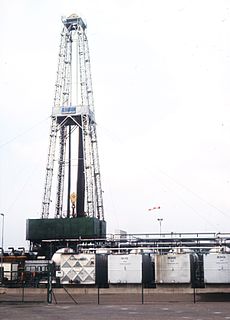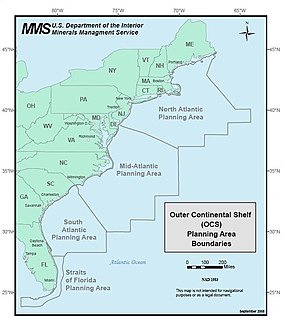A dry-hole clause is a provision in an oil or Natural gas lease specifying what a lessee must do to maintain the lease for the remainder of a primary term after drilling a "dry hole." Usually, the lessee will just have to pay delay rentals.

Spindletop is an oil field located in the southern portion of Beaumont, Texas, in the United States. The Spindletop dome was derived from the Louann Salt evaporite layer of the Jurassic geologic period. On January 10, 1901, a well at Spindletop struck oil. The Spindletop gusher blew for 9 days at a rate estimated at 100,000 barrels (16,000 m3) of oil per day. Gulf Oil and Texaco, now part of Chevron Corporation, were formed to develop production at Spindletop. The Spindletop discovery led the United States into the oil age. Prior to Spindletop, oil was primarily used for lighting and as a lubricant. Because of the quantity of oil discovered, burning petroleum as a fuel for mass consumption suddenly became economically feasible.

Dry distillation is the heating of solid materials to produce gaseous products. The method may involve pyrolysis or thermolysis, or it may not. If there are no chemical changes, just phase changes, it resembles classical distillation, although it will generally need higher temperatures. Dry distillation in which chemical changes occur is a type of destructive distillation or cracking.

Hydrocarbon exploration is the search by petroleum geologists and geophysicists for deposits of hydrocarbons, particularly petroleum and natural gas, in the Earth using petroleum geology.
Aircraft leases are leases used by airlines and other aircraft operators. Airlines lease aircraft from other airlines or leasing companies for two main reasons: to operate aircraft without the financial burden of buying them, and to provide temporary increase in capacity. The industry has two main leasing types: wet-leasing, which is normally used for short-term leasing, and dry-leasing which is more normal for longer-term leases. The industry also uses combinations of wet and dry. For example, when the aircraft is wet-leased to establish new services, then as the airline's flight or cabin crews become trained, they can be switched to a dry lease.

The Mineral Leasing Act of 1920 30 U.S.C. § 181 et seq. is a United States federal law that authorizes and governs leasing of public lands for developing deposits of coal, petroleum, natural gas and other hydrocarbons, in addition to phosphates, sodium, sulfur, and potassium in the United States. Previous to the act, these materials were subject to mining claims under the General Mining Act of 1872.

The East Texas Oil Field is a large oil and gas field in east Texas. Covering 140,000 acres (57,000 ha) and parts of five counties, and having 30,340 historic and active oil wells, it is the second-largest oil field in the United States outside Alaska, and first in total volume of oil recovered since its discovery in 1930. Over 5.42 billion barrels of oil have been produced from it to-date. It is a component of the Mid-Continent Oil Province, the huge region of petroleum deposits extending from Kansas to New Mexico to the Gulf of Mexico.
A finance lease is a type of lease in which a finance company is typically the legal owner of the asset for the duration of the lease, while the lessee not only has operating control over the asset, but also some share of the economic risks and returns from the change in the valuation of the underlying asset.
Mineral rights are property rights to exploit an area for the minerals it harbors. Mineral rights can be separate from property ownership. Mineral rights can refer to sedentary minerals that do not move below the Earth's surface or fluid minerals such as oil or natural gas. There are three major types of mineral property; unified estate, severed or split estate, and fractional ownership of minerals.
The California Department of Conservation is a department within the government of California, belonging to the California Natural Resources Agency. With a team of scientists, engineers, environmental experts, and other specialists, the Department of Conservation administers a variety of programs vital to California's public safety, environment and economy. The department's mission is to manage California's working lands. It regulates oil, natural gas and geothermal wells; studies and maps earthquakes and other geologic phenomena; maps and classifies areas containing mineral deposits; ensures reclamation of land used for mining; and administers agricultural and open-space land conservation programs. A division within the department dedicated to encouraging beverage container recycling has been moved into the newly created Department of Resources Recovery and Recycling (CalRecycle). Despite the similar name, the Department of Conservation should not be confused with the California Conservation Corps, another department within the Natural Resources Agency, which provides work experience for young adults. The Department of Conservation often collaborates with its federal equivalents, such as the U.S. Geological Survey.
BP America Production Co. v. Burton, 549 U.S. 84 (2006), was a United States Supreme Court case about whether a statute of limitations on government actions for contract claims applies to actions by a federal administrative agency to recover royalties on federal oil and gas leases. After two members recused themselves, the court ruled unanimously that it does not apply, in an opinion by Justice Samuel Alito.
Oil and gas law in the United States is the branch of law that pertains to the acquisition and ownership rights in oil and gas both under the soil before discovery and after its capture, and adjudication regarding those rights.
Thomas Baker Slick Sr. was born in Shippenville, Clarion County, Pennsylvania to Johnson M. and Mary A. Baker Slick. He became notable in 1912 for discovering Oklahoma's then-largest oil field, the Cushing Oil Field.
Offshore oil and gas in the United States provides a large portion of the nation’s oil and gas supply. Large oil and gas reservoirs are found under the sea offshore from Louisiana, Texas, California, and Alaska. Environmental concerns have prevented or restricted offshore drilling in some areas, and the issue has been hotly debated at the local and national levels.

Offshore drilling for oil and gas on the Atlantic coast of the United States took place from 1947 to the early 1980s. Oil companies drilled five wells in Atlantic Florida state waters and 51 exploratory wells on federal leases on the outer continental shelf of the Atlantic coast. None of the wells were completed as producing wells. All the leases have now reverted to the government.
Lingle v. Chevron U.S.A. Inc., 544 U.S. 528 (2005), was a landmark case in United States regulatory takings law whereby the Court expressly overruled precedent created in Agins v. City of Tiburon. Agins held that a government regulation of private property effects a taking if such regulation does not substantially advance legitimate state interests. Writing for the Court, Justice O’Connor found the test untenable for a number of reasons, but declined to grant Chevron relief because Chevron’s motion before the court was limited to a discussion of the “substantially advances” theory which had just been struck down. The Court remanded to the Ninth Circuit for a determination of whether the statute exacted a taking according to the formula of Penn Central.
Offshore oil and gas in the Gulf of Mexico is a major source of oil and natural gas in the United States. The western and central Gulf of Mexico, which includes offshore Texas, Louisiana, Mississippi, and Alabama, is one of the major petroleum-producing areas of the United States. Oil production from US federal waters in the Gulf of Mexico reached an all-time annual high of 1.65 million barrels per day in 2017. Oil production is expected to continue the upward trend in 2018 and 2019, based on ten new oil fields which are planned to start production in those years. According to the Energy Information Administration, "Gulf of Mexico federal offshore oil production accounts for 17% of total U.S. crude oil production and federal offshore natural gas production in the Gulf accounts for 5% of total U.S. dry production."
A habendum clause is a clause in a deed or lease that defines the type of interest and rights to be enjoyed by the grantee or lessee.
In the oil and gas industry, a farmout agreement is an agreement entered into by the owner of one or more mineral leases, called the "farmor", and another company who wishes to obtain a percentage of ownership of that lease or leases in exchange for providing services, called the "farmee." The typical service described in farmout agreements is the drilling of one or more oil and/or gas wells. A farmout agreement differs from a conventional transaction between two oil and gas lessees, because the primary consideration is the rendering of services, rather than the simple exchange of money.
A Continuous Drilling Provision or "Continuous Operations Provision" is a legal contract clause commonly found in oil and gas leases in the petroleum industry.

The discovery of the Glenn Pool Oil Reserve in 1905 brought the first major oil pipelines into Oklahoma, and instigated the first large scale oil boom in the state. Located near what was—at the time—the small town of Tulsa, Oklahoma, the resultant establishment of the oil fields in the area contributed greatly to the early growth and success of the city, as Tulsa became the petroleum and transportation center of the state, and the world. Several Creek Indian land allotment owners became millionaires; Oklahoma became the world's largest oil producer for years; and the area benefited from the generation of more wealth than the California Gold Rush and Nevada Silver Rush combined, as well as the increased investment capital and industrial infrastructure the boom brought with it. The town of Glenpool, Oklahoma was founded in 1906 as a direct result of the oil reserve's discovery.